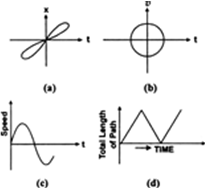
Acceleration due to gravity always acts in the downward direction, irrespective of the direction of motion.
Read each statement carefully and state if it is true or false:
A particle in one dimensional motion:
(a) with zero speed at an instant may have non-zero acceleration at that instant;
(b) with zero speed may have non-zero velocity;
(c) with constant speed must have zero acceleration;
(d) with positive value of acceleration must be speeding up.
(a) True; when the body is projected vertically upward, then the speed of the particle at the highest point is zero but has an acceleration equal to the acceleration due to gravity.
(b) False; because
|Displacement| ≤ Distance
∴|Velocity| ≥ Speed
Thus, the speed of the body zero implies that the magnitude of velocity of the particle is zero. Hence the velocity of body is zero.
(c) True; since motion is in one dimension, therefore there are only two possible directions of motion. Since speed is constant, therefore motion can be accelerated if the direction of motion changes instantaneously.
i.e. acceleration of particle is infinite, which is not possible in practice.
(d) False; because if acceleration is positive, then it need not be necessary that particle will always speed up, it may slow down. The particle will speed up if velocity is also positive.
State True or False:
A particle in one-dimensional motion
A.
(a) with zero speed at an instant may have non-zero acceleration at that instant
Look at the graphs (a) to (d) carefully and state, with reasons, which of these cannot possibly represent one-dimensional motion of a particle.


(b) Since velocity is a single valued function, therefore at any instant, the particle cannot have two different velocities, hence the graph cannot represent motion.
(c) Since speed is magnitude of velocity which cannot be negative, therefore, graph is not possible.
(d) Total length of path travelled by particle cannot decrease with the time. Therefore, graph is not possible.
